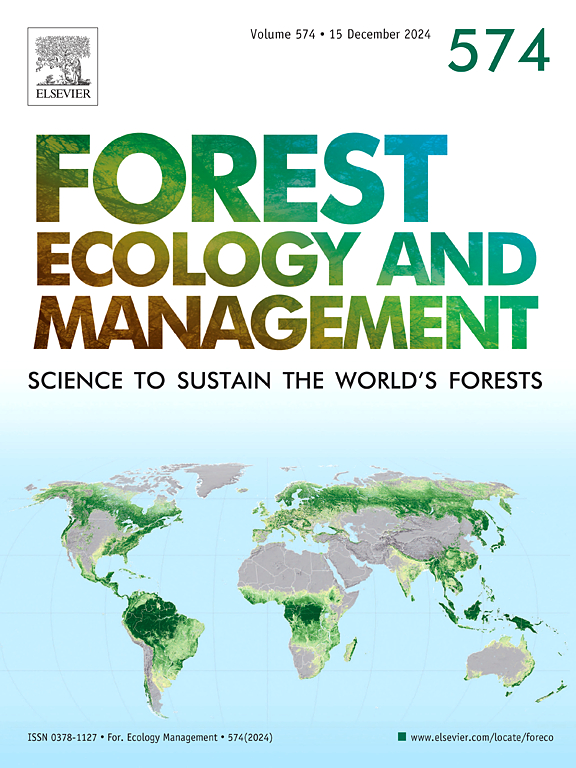Scale- and age-dependent climate response patterns revealed in Pinus sylvestris var. mongolica and Larix principis-rupprechtii plantations in northern China
IF 3.7
2区 农林科学
Q1 FORESTRY
引用次数: 0
Abstract
Inconsistent forest climate response patterns across organizational scales or stand ages are increasingly documented due to the large organismal size and the long-lived nature of forest ecosystems, complicating the prediction of forest productivity trajectories. However, studies integrating the scale- and age-dependent climate responses and accounting for species-specific functional strategies are lacking, limiting our ability to assess forest-wide productivity and resilience under increasing drought stress. In this study, we investigated the climate sensitivity of radial growth (RWI) and canopy vitality (NDVI) at different growth stages for Larix principis-rupprechtii (Prince Rupprecht’s larch) and Pinus sylvestris var. Mongolica (Mongolian pine) plantations in Saihanba, the world’s largest plantation. Through integrated analysis of dendrochronological, remote sensing, and climatic datasets from 1984 to 2020, we sought to reveal distinct scale- and age-dependent climate response mechanisms of these two species. We found that individual tree-level radial growth exhibited stronger climatic sensitivity than stand-level canopy vitality, as evidenced by more pronounced inter-annual variability with climate fluctuations and greater resilience to drought events in RWI than in NDVI. Climate response patterns shifted across ontogenetic stages, with trees at juvenile stages responding more strongly to climate variables closely associated with environmental water conditions. Post-drought density reduction caused by tree mortality alleviated the competition for water resources among trees in mature stands, promoting tree growth release in Prince Rupprecht’s larch but not in Mongolian pine. This divergence may stem from larch’s more acquisitive resource-use strategy, characterized by anisohydric behavior and deciduous leaf habit, which enhances its capacity to capitalize on resource availability increases following the drought-driven tree mortality but restricts extreme drought resilience. These findings highlight the imperative to integrate multi-scale metrics for robust assessments of forest drought resilience and advocate for age- and species-specific forest management, such as targeted thinning, to optimize adaptive silvicultural interventions under intensifying climatic stressors.
中国北方樟子松和华北落叶松人工林气候响应的尺度和年龄特征
不同组织尺度或林分年龄的森林气候响应模式的不一致越来越多地被记录下来,这是由于森林生态系统的大生物规模和长寿命性质,使森林生产力轨迹的预测复杂化。然而,缺乏整合尺度和年龄依赖的气候响应以及考虑物种特定功能策略的研究,限制了我们在日益严重的干旱压力下评估森林生产力和恢复力的能力。本文研究了世界最大人工林塞汉坝落叶松(Larix principis-rupprechtii)和蒙古松(Pinus sylvestris var. Mongolica)人工林不同生长阶段径向生长(RWI)和林冠活力(NDVI)的气候敏感性。通过对1984 - 2020年树木年代学、遥感和气候数据的综合分析,揭示了这两个物种不同的尺度和年龄气候响应机制。研究发现,相对于林分水平的林冠活力,单株林分水平的径向生长表现出更强的气候敏感性,RWI的年际变化更明显,对干旱事件的适应能力也比NDVI强。气候响应模式在不同的个体发育阶段发生变化,树木在幼龄阶段对与环境水分条件密切相关的气候变量的响应更为强烈。干旱后树木死亡导致的密度降低缓解了成熟林分树木之间的水资源竞争,促进了落叶松树木的生长释放,而对蒙松没有促进作用。这种差异可能源于落叶松更具获取性的资源利用策略,其特征是各向异性行为和落叶习性,这增强了其利用干旱导致树木死亡后资源可用性增加的能力,但限制了极端干旱的适应能力。这些发现强调,必须整合多尺度指标,对森林抗旱能力进行强有力的评估,并倡导针对特定年龄和物种的森林管理,如有针对性的间伐,以优化气候压力加剧下的适应性造林干预措施。
本文章由计算机程序翻译,如有差异,请以英文原文为准。
求助全文
约1分钟内获得全文
求助全文
来源期刊

Forest Ecology and Management
农林科学-林学
CiteScore
7.50
自引率
10.80%
发文量
665
审稿时长
39 days
期刊介绍:
Forest Ecology and Management publishes scientific articles linking forest ecology with forest management, focusing on the application of biological, ecological and social knowledge to the management and conservation of plantations and natural forests. The scope of the journal includes all forest ecosystems of the world.
A peer-review process ensures the quality and international interest of the manuscripts accepted for publication. The journal encourages communication between scientists in disparate fields who share a common interest in ecology and forest management, bridging the gap between research workers and forest managers.
We encourage submission of papers that will have the strongest interest and value to the Journal''s international readership. Some key features of papers with strong interest include:
1. Clear connections between the ecology and management of forests;
2. Novel ideas or approaches to important challenges in forest ecology and management;
3. Studies that address a population of interest beyond the scale of single research sites, Three key points in the design of forest experiments, Forest Ecology and Management 255 (2008) 2022-2023);
4. Review Articles on timely, important topics. Authors are welcome to contact one of the editors to discuss the suitability of a potential review manuscript.
The Journal encourages proposals for special issues examining important areas of forest ecology and management. Potential guest editors should contact any of the Editors to begin discussions about topics, potential papers, and other details.
 求助内容:
求助内容: 应助结果提醒方式:
应助结果提醒方式:


